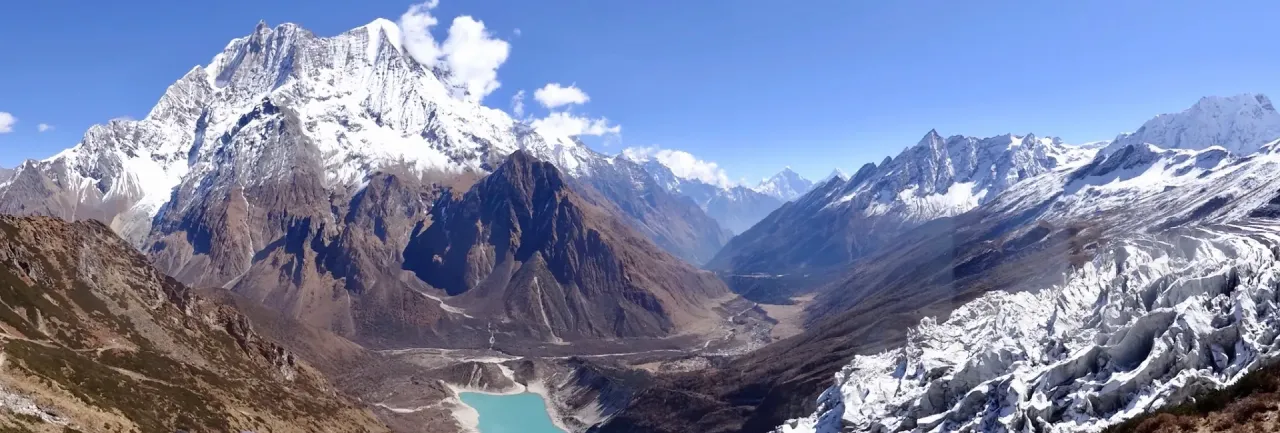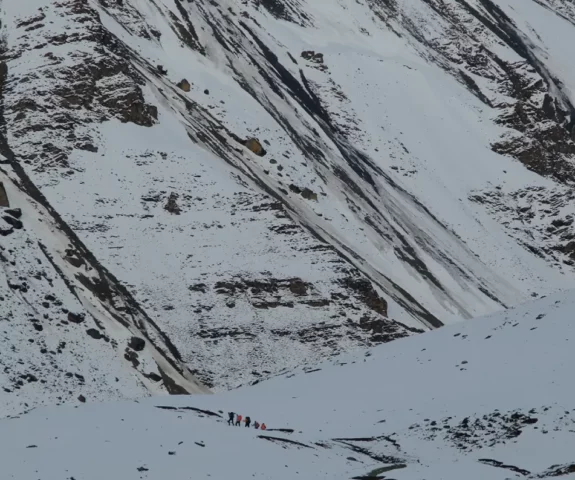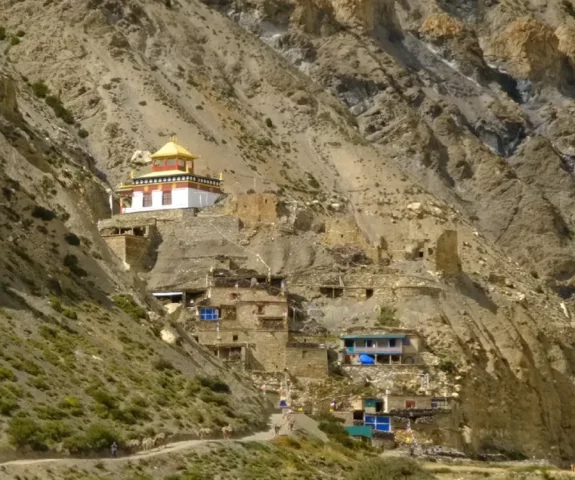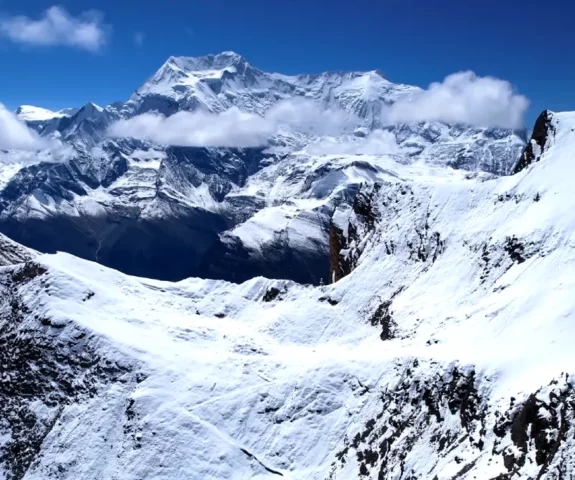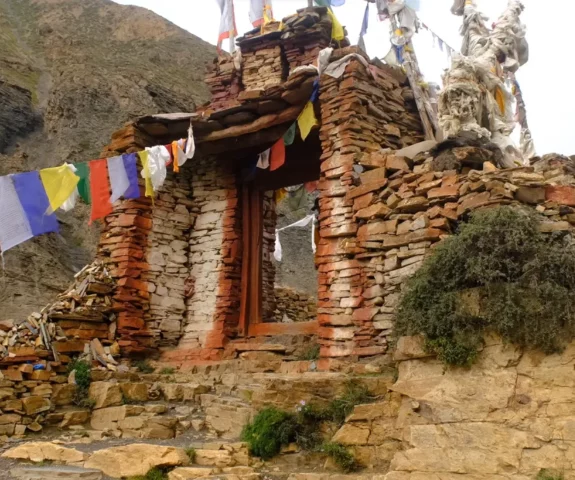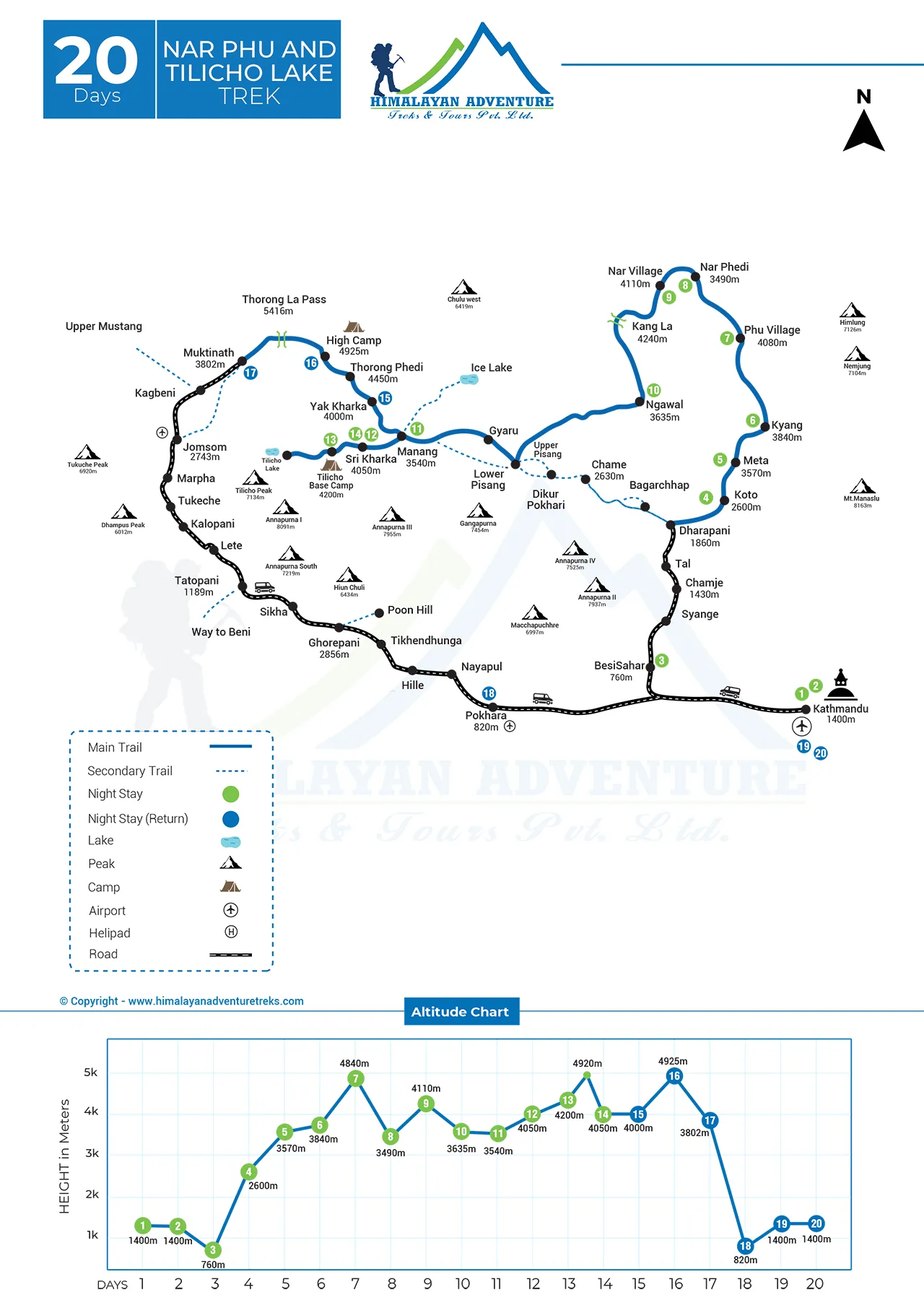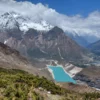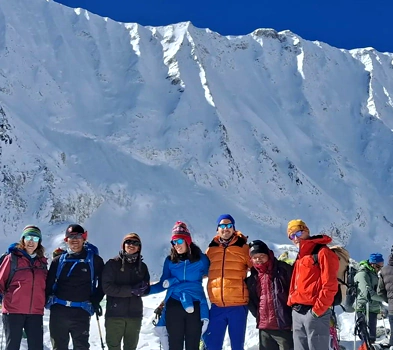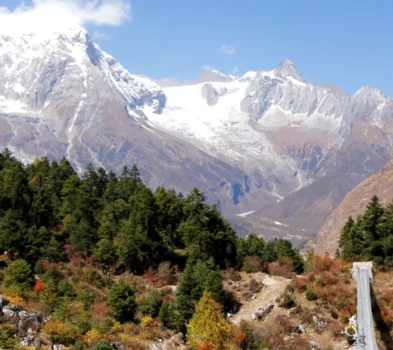Duration
20 DaysNar Phu and Tilicho Lake Trek
Trip Grade
DifficultGroup Size
1-16 PeopleMax Altitude
5,240m. / 17,192ft.Best Season
Feb- May/ Sept-NovActivity
Trekking and HikingMeals
Breakfast, Lunch & DinnerAccommodation
Hotels & TeahousesTransportation
Private Vehicle & BusTrip Customization
On request (click here)Highlights of Nar Phu and Tilicho Lake Trek
- Rediscover the lost horizons of Nar and Phu and celebrate in their unspoiled raw charm
- Spend a serene time at the shore of one of the highest and largest alpine lake of Tilicho
- Experience the triumphant journey over the two prominent passes of Kang La and Thorong La
- Bask in the company of the striking outlines of the Annapurna range, Kanguru, Nilgiri, Khangsar Kang, Gangapurna, Tilicho, and Dhaulagiri
- Observe the medieval Tibetan culture that will journey you back in time
- Experience all the climatic zones from subtropical lowlands to the temperate zone of Annapurna to the alpine and Martian landscape of Mustang
- Meet the elusive snow leopard and blue sheep
Trip Introduction
No one is unfamiliar with the Mustang or Annapurna circuit trail in Nepal, but a few km away east of Mustang and north of Annapurna, are two lost horizons which are called the Cloud-Dwellers of the Himalayas. Are you fascinated and want to reach these elusive primitive gems of Annapurna? Then welcome to our Nar Phu and Tilicho Lake trek- a journey into the unknown land.
Our Nar Phu trek will take you to the hard-to-reach Tibetan Highlands of Nar and Phu, which are full of ancient cave cities and monasteries, ancient forests, and bizarre rocks. These are far from the beaten track and normal tourist areas, with very few visitors every year who get to see the customs of medieval Tibet and the mountain landscapes that will take your breath away.
In addition to the amazing Nar and Phu, you will also get to see the Tilicho Lake– one of the highest-altitude and longest reservoirs in the world (4920 m) located in Manang with water of heavenly blue surrounded by the brown valley and the white snowy walls.
Your Nar Phu and Tilicho Lake trek commences from Besisahar, one of the picturesque villages of the Annapurna Circuit. Then the path diverges from the main trail at Koto and takes you to the lesser-known trails of the enchanting Nar Phu Valley.
Here you are in the fabulous, magical land of the Phu and Nar, where Buddhist Bhotiyas of Tibetan descent reside. Although just a few km from the Annapurna circuit, the two regions are well secluded and filled with heavenly bliss and lively monasteries.
After completing your Nar Phu Valley trek, you will now walk in the remote trails in the mountain valleys north of Manang and cross the Kang La Pass that extends to an altitude of 5240 m.
Be prepared to be immersed in the delicious spectacle of Tilicho (7134 m), Himlung (7126 m), Annapurna III (7555 m), Kanguru (6367 m), Annapurna II (7937 m), Gangapurna (7455 m), and Annapurna IV (7525 m).
This pass links the Nar and Phu with the Manang Villages, from where you will progress towards the Tilicho base Camp (4150 m). Walking from the camp, you will reach Tilicho Lake where the enchanting shadow of the snow-draped peaks of Nilgiri (7061 m), Khangsar (7485 m), and Tilicho Peaks can be seen mirrored in its shimmering turquoise waters.
This lake is often related to the Kak Bhusundi lake depicted in the Ramayana and is often believed to be the site where the first verses of this epic Veda were recited.
Your Tilicho Lake trek ends here, and now you will head west to the Annapurna trail to reach the highest point of the journey- the fearsome Thorong La Pass at 5416 m.
Allured by the grandest spectacle of Thorong Peak (6144 m), Annapurna, Nilgiri, and Dhaulagiri (8167 m), you will descend into lower Mustang along trails leading to holy Muktinath before heading to Jomsom. Finally, your route ends in Jomsom, and then you will journey back to by road to Kathmandu through Pokhara.
Undeniably, the Nar Phu and Tilicho Lake trek is very arduous and suitable only for those who have already gained considerable hiking experience. Yet, there will be culture, nature, and historical heritage for miles, and this will certainly be remembered as one of the many great experiences.
Outline Itinerary of Nar Phu and Tilicho Lake Trek
Day 01: Arrival at Kathmandu Airport.
Day 02: Kathmandu Valley Sightseeing.
Day 03: Drive from Kathmandu to Besisahar (760 m).
Day 04: Drive from Besisahar to Koto (2600 m).
Day 05: Trek from Koto to Meta (3570 m).
Day 06: Trek from Meta to Kyang (3840 m).
Day 07: Trek from Kyang to Phu Village (4080 m).
Day 08: Trek from Phu Village to Nar Phedi (3490 m).
Day 09: Trek from Nar Phedi to Nar Village (4110 m).
Day 10: Trek from Nar Village to Ngawal (3675 m) via Kang La Pass (5240 m).
Day 11: Trek from Ngawal to Manang (3540 m).
Day 12: Trek from Manang to Sri Kharka (4080 m).
Day 13: Trek from Sri Kharka to Tilicho Base Camp (4150m).
Day 14: Trek from Tilicho Base Camp to Tilicho Lake (4920 m) and Back to Sri Kharka.
Day 15: Trek from Sri Kharka to Yak Kharka (4020 m).
Day 16: Trek from Yak Kharka to Thorong High Camp (4880 m).
Day 17: Trek from High Camp to Muktinath (3800 m) via Thorong La Pass (5416 m).
Day 18: Drive from Muktinath to Pokhara.
Day 19: Drive from Pokhara to Kathmandu.
Day 20: Departure to Airport.
Our guests sharing their experiences (Photo/Video Gallery)
Detail itinerary of Nar Phu and Tilicho Lake Trek
Day 01: Arrival at Kathmandu Airport.
Welcome to the fascinating city of Kathmandu with a beautiful bouquet of unique sights and culture. AT TIA, you will be met by our representative who will drive you through the enchanting streets of Kathmandu to your hotel.
Please make yourself comfortable and go outside to see the vendors, bazaars, houses, and markets of the capital. Till then, all the participating members of our Nar Phu Trek will arrive.
Our tour guide will organize a small gathering and pre-trip meeting so you will get to know what lies ahead in the following days. Spend the evening as you desire for we have a whole day tomorrow to enjoy Kathmandu.
Activity: Airport Pickup, 30min
Max. Altitude: 1,400m/4,593ft. Kathmandu
Accommodation: Hotel
Day 02: Kathmandu Valley Sightseeing.
We will start our morning today with a drive to Pashupatinath Temple where you will breathe peace and see numerous gold-plated small temples and the cremation at Aryaghat. Then, a drive further will take you to Boudhanath – an extraordinarily beautiful white stupa surrounded by a multi-colored mandala.
From Boudhanath, we will drive to Swayambhunath Temple lying calmly atop a hill overlooking the entire Valley of Kathmandu. Then we will go to the old part of Kathmandu to Basantapur where there is a palace of the living goddess.
It is now time that we gear up for the Nar Phu and Tilicho Lake Trek. We will check equipment, and make sure everything is in place for our adventure.
Activity: Sightseeing, 6-7 hours
Max. Altitude: 1,400m/4,593ft. Kathmandu
Meal: Breakfast
Accommodation: Hotel
Day 03: Drive from Kathmandu to Besisahar (760 m).
Right after breakfast, we will engage in a long but beautiful drive out of Kathmandu through the Kalanki and Thankot Pass towards Trishuli. Then the long elongated road of Prithvi Highway will lead us to Dumre town.
From here starts the Besisahar Chame Highway which will take us toward the enigmatic town of Bandipur. The gigantic Annapurna is enchantingly visible from here.
Following the same Highway, we will proceed towards Besisahar which transfer us to the refreshing Marshyangdi Valley. This charming town of Lamjung district with a mix of Gurungs, Brahmins, Tamang, and other communities will be our shelter for the night.
We can just feel the tranquility here while admiring the imposing visuals of Manaslu and Annapurna.
Activity: Drive, 6-7 hours
Max. Altitude: 760m/2,493ft. Besisahar
Meal: Breakfast, Lunch & Dinner
Accommodation: Teahouse
Day 04: Drive from Besisahar to Koto (2600 m).
From Besisahar, we will change to the local sharing jeep and drive north through the lower Marshyangdi Valley and arrive at Jagat which means we are now in the land of Manang Valley.
The road gets steeper as we proceed towards Chamje (1400 m) crossing the impressive Marshyangdi River. The Highway will not stop rising eventually leading us to the Tal Village where we will see the first Mani Walls hinting we are entering Tibetan-Buddhist country.
The road of the valley gets steeper and more rugged as we keep on progressing to Karte and then to Dharapani (1900 m). We will now head west and keep on driving till we are at Bagarchhap town (2160 m).
As we keep on admiring the Lamjung and Annapurna peaks, we will in no time reach the village of Danakayu (2300 m). The Marshayangdi path will now lead us to Latamarang (2400 m) and eventually to Koto located just at the starting point of Phu Khola.
From here begins the Nar Phu country giving us a glimpse of the authentic Tibetan realm.
Activity: Drive, 6-7 hours
Max. Altitude: 2,600m/8,530ft. Koto
Meal: Breakfast, Lunch & Dinner
Accommodation: Teahouse
Day 05: Trek from Koto to Meta (3570 m).
The region of Annapurna will leave us now as we exit Koto on foot beginning our hiking adventure. After registering to enter Nar and Phu Valley, we will proceed north and cross a highly suspended bridge. A magically stunning and steep canyon will show us our trail that runs high above the riverbed.
We will now make our ascent to 3230 m high Dharmasala where we may take the nourishing Dal Vat to gain the power for the next leg of the journey. Lamjung, the Annapurna II, and Pisang Peaks will give us their beautiful company as we advance further along the steeper section of the trail through the open terrain and scarce forest till we reach Meta.
Activity: Trek, 6-7 hour
Max. Altitude: 3,570m/11,713ft. Meta
Meal: Breakfast, Lunch & Dinner
Accommodation: Teahouse
Day 06: Trek from Meta to Kyang (3840 m).
We have planned an acclimatization walk today so we will be slowly ascending towards the higher altitude of Kyang. Taking off the beaten track and walking alongside the caravan of mules and yaks, we slowly enter residential areas with many abandoned villages.
We will cross a few ravines and pass through the last remnants of the birch forest till we arrive at the complete desert highland of Junam Goth (3690 m) from where we will pass by Chyako and then head to Kyang to take refuge for the night in one of its small tea houses.
Activity: Trek, 4-5 hours
Max. Altitude: 3,840m/12,598ft. Kyang
Meal: Breakfast, Lunch & Dinner
Accommodation: Teahouse
Day 07: Trek from Kyang to Phu Village (4080 m).
We have one of the most gorgeous travel today as we will be entering the most attractive landscape of Nepal. After Kyang, we will take the path that hangs high above the river along the edges of the cliff.
It may seem impassable but once we get going, it will become easier and more beautiful. Eventually, we will arrive at the mouth of the Phu Valley. Now, the high gorges and the valley become easier but we will have to hike upward for about 20 minutes.
Now, the series of Mani Walls start to appear and the trail turns straight out. Our next 30-minute trek will be much simpler till we reach the Phu itself.
The landscape, the architecture, the houses, and the people are truly really special here. And above all, the majestic peaks of Amotsang, Kanguru, Dhaulagiri, Gangapurna, Annapurna South, and I, Pokhar Khang, and Manaslu create a magical atmosphere in the valley.
Activity: Trek, 3-4 hours
Max. Altitude: 4,080m/13,386ft. Phu Village
Meal: Breakfast, Lunch & Dinner
Accommodation: Teahouse
Day 08: Trek from Phu Village to Nar Phedi (3490 m).
From Phu, we will head south and once again take the same exposed path that brought us to Phu. Navigating back through Kyang and Chyako, we will arrive at Junam Goth from where we will walk through the pastures for some time.
Then, we will descend along the rugged trail sharply making our way down to Mahendra Pul (Bridge). The gorge under the bridge seems deep but the bridge is safe to cross.
The route now becomes straight till we reach Nar Phedi where we will be taking refuge for the night. The village has beautiful Nar Phedi Gumba (Monastery) which sits restfully with the beautifully built guesthouse.
Activity: Trek, 5-6 hours
Max. Altitude: 3,490m/11,450ft. Nar Phedi
Meal: Breakfast, Lunch & Dinner
Accommodation: Teahouse
Day 09: Trek from Nar Phedi to Nar Village (4110 m).
From the guesthouse of the monastery, we will take on the steepened path that will go on rising till we make it to our destination- the enchanting Nar Gaun (Village).
As we keep on pushing, we will reach the suddenly expanded landscape that reveals the most charming series of Mani Walls with Kanguru sparkling in the background.
After a demanding journey of about 2 to 3 hours, we will finally make it to the grounds of Nar Village which is translated as the land of blue sheep. Comparatively, the village is slightly larger than its neighbor Phu but the Tibetan Buddhism influence is the same.
The popular trail to the Annapurna Circuit is just a few km away yet this area still remained untouched and unspoiled.
Activity: Trek, 2-3 hours
Max. Altitude: 4,110m/13,484ft. Nar Village
Meal: Breakfast, Lunch & Dinner
Accommodation: Teahouse
Day 10: Trek from Nar Village to Ngawal (3675 m) via Kang La Pass (5240 m).
Today is the high mountain pass day as we have the massive Kang La Pass to cross. The pass crossing is not technically challenging but its altitude still passes over 5000 m elevation.
Taking things slowly, we will ascent the Temdenzon Khola mound and reach the simple stone huts of the Kanga La Phedi. Kanguru, Manaslu, and Ganesh fantastically shine in the distance as we commence our hardships climbing numerous ravines and cliffs.
After a few hours, a small mountain lake can be seen but the Pass is still not visible to our naked eyes. Ending our hardships, we are finally at the narrowest tip of the Pass.
The Kanguru, Tilicho Peak, Annapurna II, III, IV, Himlung, and Gangapurna are at their most perfect glory. After absorbing the astounding views, we will now take on the sharp descent from the pass to reach Ngawal.
For the first few hundred meters, the downhill track will be steeper but later, the path ultimately flatten out as we make it to the land of the village.
The wildest views of the massive Annapurna range will relieve our fatigued bodies as we prepare to rest in one of the finest villages of the Manang Valley. Here, we just finished our amazingly adventurous Nar Phu Valley trek and soon be starting the Tilicho Lake trek.
Activity: Trek, 7-8 hours
Max. Altitude: 5,240m/17,192ft. Ngawal
Meal: Breakfast, Lunch & Dinner
Accommodation: Teahouse
Day 11: Trek from Ngawal to Manang (3540 m).
Leaving Ngawal, we will descend along the sharp steep trail which will direct us to the valley floor. Slowly, the landscape will begin to transition from the plant-scarce area to the enchanting forest with tall trees.
Shortly, we will be at Humde where we will take the trail back of the town and reach the large expansive grassy land. We are heading to Braga (3450 m) where the main wide road begins easier for our legs.
Walking along the motorable path, we will encounter many bikers who will also be going to Manang. We will have to deal with a small ascension to Mungli before we enter the welcoming gate of Manang.
Gangapurna Peak and its glacier look enormous from here. The village itself is very happening where we can see numerous tourists and locals getting on with their business.
One of the notable structures here is the building of the Himalayan Rescue Association (HRA) which is quite amazing as it offers lectures on the prevention of acute mountain sickness.
Activity: Trek, 3-4 hours
Max. Altitude: 3,540m/11,614ft. Manang
Meal: Breakfast, Lunch & Dinner
Accommodation: Teahouse
Day 12: Trek from Manang to Sri Kharka (4080 m).
Marshyangdi River will once again greet us as we progress on our trail toward Tilicho Lake. After Manang, we will take the trail that runs parallel to the gigantic river. A short while after, we will come across a suspended metal bridge that will take us across the river towards the path that slopes the mountain.
In about 2 hours, we will arrive at Khangshar- a small Tibetan settlement that provides the delicious spectacle of Tilicho Peak, Gangapurna, Pisang, and Annapurna.
Now traversing a gentle slope, we will arrive at Sri Kharka where we will rest the night in the wild highland to get as well acclimatized as we can before reaching the Tilicho Lake.
Activity: Trek, 4-5 hours
Max. Altitude: 4,080m/13,386ft. Sri Kharka
Meal: Breakfast, Lunch & Dinner
Accommodation: Teahouse
Day 13: Trek from Sri Kharka to Tilicho Base Camp (4150m).
After Sri Kharka, we will be involved in the sharp ascent for about 30 minutes after which we will meet the same old suspension bridge. The trail after the bridge will take us to the scree of Tilicho slope.
Khangsar Kang starts to become more and more prominent as we progress along the descent towards the Tilicho base Camp. The path will be full of loose rocks and stones so we have to be extra vigilant.
We will traverse the Tilicho scree for about 20 minutes till we make it to the Tilicho Base Camp. It has around three shelters and one of them will be our refuge for the night.
Tilicho, Khangsar Kang, and Gangapurna look marvelously beautiful from the base camp.
Activity: Trek, 4-5 hours
Max. Altitude: 4,150m/13,615ft. Tilicho Base Camp
Meal: Breakfast, Lunch & Dinner
Accommodation: Teahouse
Day 14: Trek from Tilicho Base Camp to Tilicho Lake (4920 m) and Back to Sri Kharka.
From the Tilicho base camp, we will take on the sharp ascent for about 1 to 2 hours. Mind you, there can be slippery snow on the trail but crampons will not be necessary for the crossing.
After this challenging climbing section, the trail will be on level terrain which will take an additional 30 minutes of crossing.
Here we are at the beautiful Tilicho Lake- supposedly the highest-altitude Lake whose shoreline stands against the shiny mirror of the giant walls of ice and snow.
Encircling the lake are Nilgiri, Khangsar, Muktinath, and Tilicho Peaks which beautifully reflect their shadow on the clearest waters of the lake.
For the Hindus, this lake is the Kak Bhusundi Lake which has been mentioned in the Ramayana so it holds a religious place for the people.
We will now retrace to Tilicho Base Camp and descend to Sri Kharka for the overnight shelter.
Activity: Trek, 6-7 hours
Max. Altitude: 4,920m/16,142ft. Tilicho Lake
Meal: Breakfast, Lunch & Dinner
Accommodation: Teahouse
Day 15: Trek from Sri Kharka to Yak Kharka (4020 m).
From Sri Kharka, we will take a left turn and reach the Viewpoint from where we can observe the beautiful Manang Valley. From the Pass, we will now sharply go down and be very vigilant as there can be slippery icy patches on the trail.
We will now meet the small rickety wooden bridge that will walk us over the Thorong Khola and take us to the main path marked the Yak Kharka.
Justifying its name, we can truly see many yaks lazily grazing around the field, and among such herds is our tea house which will provide warm shelter for the night.
Here we go, we have completed our Tilicho Lake trek and returned to the Annapurna Circuit.
Activity: Trek, 4-5 hours
Max. Altitude: 4,020m/13,189ft. Yak Kharka
Meal: Breakfast, Lunch & Dinner
Accommodation: Teahouse
Day 16: Trek from Yak Kharka to Thorong High Camp (4880 m).
The trail after Yak Kharka will lead us to one more suspended bride this time spanning over the huge Marshyangdi River. The pathway now advances us to the small village of Ledar from where we will commence to sharply climb the slope.
The landscape here resembles that of the moon but the views are awesome to take a frequent rest in between. A strenuous hardship will ultimately lead us to the Thorong High Camp or Phedi where to much of our surprise, the enthralling mountain peaks await our arrival: Syagang, Khatungkan, Gundang, and Thorung Peaks.
Truly, it is an incredibly beautiful place amidst the most beautiful mountains and the rugged rocky terrain.
Activity: Trek, 4-5 hours
Max. Altitude: 4,880m/16,010ft. Thorong High Camp
Meal: Breakfast, Lunch & Dinner
Accommodation: Teahouse
Day 17: Trek from High Camp to Muktinath (3800 m) via Thorong La Pass (5416 m).
Another mountain pass day has arrived when we have to cross one of the most famous passes of Nepal: the Thorong La. The Pass and the trail to the pas sis completely manageable although the steepness and the altitude will keep testing our resilience.
For about an hour, we will tackle the sharp incline, now the path becomes a bit easier and more beautiful. After we are above 5000 m, we will enter a small valley where we may find a tiny tea house.
We will come across numerous alpine streams as we progress to the tip of the Pass. We may get confused as there are numerous false summits in between but our guide will lead us to the true summit of the Pass.
Although exhausted, our effort will be well paid off by the astonishingly up-close views of Thorong Peak, Annapurna, Nilgiri, and Dhaulagiri. Now we will engage in equally steep descent for about 3 to 5 hours when we lose almost 1600 m altitude.
Slowly, the Kali Gandaki Valley comes into view as we make it to Jhong Khola. And, finally, we will be at the sacred grounds of Muktinath known as one of the pious pilgrims of Asia.
The village has a temple complex including the Vishnu and Jwala Mai temples and the eternal natural flame along with 108 holy springs. The components of water, fire and the sacred Himalayan air make this site very pious for both Hindus and Buddhists.
Activity: Trek, 8-9 hours
Max. Altitude: 5,416m/17,769ft. Thorong La Pass
Meal: Breakfast, Lunch & Dinner
Accommodation: Teahouse
Day 18: Drive from Muktinath to Pokhara.
We have almost a day’s drive today from Muktnath to Pokhara via Jomsom, but it will be nothing but beautiful. The drive will be complemented by the views of Nilgiri, Annapurna, and Dhaulagiri with several other eye-catching peaks as we progress through the lower Mustang territory.
As the day approaches to end, we will be resting at the hotel in Pokhara.
Activity: Drive, 6-7 hours
Max. Altitude: 822m/2,697ft. Pokhara
Meal: Breakfast & Lunch
Accommodation: Hotel
Day 19: Drive from Pokhara to Kathmandu.
After a big adventure in the Nar and Phu Valley, and the Tilicho Lake, we are now ending our journey with a tourist bus drive to Kathmandu. The same old Prithvi Highway will lead us back through Bandipur and Trishuli toward Kathmandu.
By the evening, we will probably be enjoying our final meal in Nepal with all our support team celebrating the success with a drink of champagne.
Activity: Drive, 8-9 hours
Max. Altitude: 1,400m/4,593ft. Kathmandu
Meal: Breakfast & Dinner
Accommodation: Hotel
Day 20: Departure to Airport.
We will drive you to TIA so you can board a flight to land in your home country after the eventful Nar Phu trek.
Activity: Airport drop, 30 min
Max. Altitude: 1,400m/4,593ft. Kathmandu Airport
Meal: Breakfast
Note:
If you have your own private group and want to make your trip private, we can run the custom trip all the day as per your requirements and group size.
Includes and Excludes
What are included with package?
- Pick/Drop Up from the Airport and Transfer to the Hotel: Comfortable airport transfers in a private vehicle both ways.
- Three-Night 3-star Hotel in Kathmandu with Breakfast: Accommodation in a centrally located 3-star hotel with daily breakfast.
- One Night 3-star Hotel in Pokhara with Breakfast: Comfortable hotel stay in Pokhara with morning breakfast included.
- Muktinath to Pokhara by Bus: Overland transport from Muktinath back to Pokhara by local bus service.
- Sightseeing in Pokhara by Private Vehicle: Guided exploration of Pokhara’s scenic attractions with a private vehicle.
- Standard Meals During Trekking (Breakfast, Lunch, Dinner): All meals provided during the trek in local lodges/tea houses.
- Kathmandu/Besisahar/Pokhara/Kathmandu by Tourist Bus: Tourist bus travel between major cities and trekking start point.
- Besisahar to Koto by Sharing Jeep: Overland transport from Besisahar to Koto in a shared local jeep.
- National Park Permit (ACAP & MCAP): Required permits for entry into Annapurna and Manaslu Conservation Areas.
- Trekkers’ Information Management System (TIMS) Permit: Mandatory TIMS card for safety and record tracking.
- Special Nar Phu Permit: Restricted area trekking permit for the Nar Phu Valley region.
- All Necessary Paperwork: Handling of all trekking-related government documentation and permits.
- All Accommodations in Tea Houses During the Treks: Comfortable tea house stays along the trekking route.
- Experienced, Helpful, Govt Licensed Guide and Porter (1 Porter for 2 Clients): Supportive guide and porter services throughout the trek.
- Medical Supplies (First Aid Kit Will Be Available): Basic medical kit carried by the guide for emergencies.
- All Government Taxes: Inclusive of all applicable taxes related to the trek and accommodations.
- Last Night’s Farewell Dinner at an Authentic Nepalese Restaurant with a Cultural Performance: A traditional Nepali meal and live cultural show to conclude your adventure.
What are not included with package?
- Nepal Visa Fee (Obtainable at Kathmandu Airport): The visa fee is not included and can be obtained at the airport upon arrival.
- International Airfare to and from Kathmandu: Flight tickets are not included in the package.
- Entrance Fee in Pokhara: Any entrance fees to attractions in Pokhara are not included.
- Extra Night Hotel Accommodation in Kathmandu: Accommodation charges for any extra nights due to early arrival, late departure, or early return from the mountain.
- All Meals in Kathmandu and Pokhara: Meals outside the trekking schedule, including lunch and dinner in Kathmandu and Pokhara, are not covered.
- Travel and Rescue Insurance: Travelers must arrange their own insurance to cover emergency evacuations or any unforeseen situations.
- Personal Expenses: Expenses such as phone calls, laundry, bar bills, battery recharge, extra porters, bottled or boiled water, hot showers, etc., are not included.
Pick Your Suitable Date
Book a Private Trip
Private & Group Discount Price
-
1 person
US$ 3500
-
2 -
2 people
US$ 2500
-
3 -
5 people
US$ 2300
-
6 -
10 people
US$ 2100
-
11 -
16 people
US$ 1900
-
17 + people
9999
US$ 1700
Total Cost:
US$ 3500
Route Map & Altitude Chart
Kathmandu
Start/End point
Kathmandu
Addon option on Nar Phu and Tilicho Lake Trek
During our Nar Phu and Tilicho Lake trek, you will be staying in three-star rated tourist-class hotels in Kathmandu and Pokhara. They are fantastically eye-appealing and well-equipped with the amenities that will ensure your pleasant stay.
However, Kathmandu and Pokhara also contain some of the world-class establishments which are rated as four and five stars. These establishments are not only elegantly furnished and sophisticated but also come with a private pool area, lush surroundings, peace and calmness along with a large garden area and exceptional staff service.
They also have their own in-built high-class restaurants and bars that offer an amazing gourmet experience along with exquisite drinks and beverages.
Really, these hotels are commendable and truly deserve an upgrade recommendation. If you also wish to enjoy some of these styles, elegance, and luxury, please tell us at the time of booking your adventure with us.
We will be glad to arrange the accommodations that suit your desires. The general cost for the upgrade is as follows:
- Kathmandu: 100 US Dollars per night for two guests, including breakfast
- Pokhara: 100 US Dollars per night for two guests, including breakfast
Please understand that these are just the indicative prices which may go higher if you wish to choose some extravagant and lavish setting for yourself.
During our Nar Phu Valley trek, we have impeccably arranged all your transportation needs. A luxurious tourist bus will transport you from Kathmandu to Besisahar while upon return you will enjoy a picturesque drive from Jomsom to Pokhara and then back to Kathmandu.
However, if you like to have a more refined travel experience, then we do offer you some enticing upgrade options. Such as Jomsom has a small airstrip enabling you to fly to Pokhara in under 20 minutes.
This way, you will have nearly an entire day in Pokhara where you can engage in some thrilling excursions or activities that will enhance your adventure.
Likewise, instead of enduring a lengthy bus ride from Pokhara to Kathmandu, you can choose a quick 30-minute flight and you can utilize the remaining time to revisit the captivating monuments and sites you may have missed on the second day of your itinerary.
The standard price for upgrading to an internal flight from Jomsom to Pokhara is 180 US Dollars per traveler and from Kathmandu to Pokhara is 125 US Dollars per traveler.
Trip Information
Essential Info
Restriction to Nar and Phu Valley
For several years, Nar and Phu did not exist for the world nor to the government of Nepal so these two primitive valleys remain as an enigma for a very long time.
However, soon the valley got into the eyes of the Tibetan refugees who found a safe refuge within the mountain walls of these remote valleys. They developed the salt trade route here which eventually raise the heads of the authorities.
Only after they noticed the envious territory and the beauty of the region, the government then opened the doors for the trekking in 2003. However, still to date, these two are recognized as a specially protected zone intended to control the number of foreign tourists.
Learning from the former mistakes, the government now likes to preserve the primitive charm, purity, tranquility, and safety of the valley that can transport visitors to an era unspoiled by modernity.
In addition, the border issue with Tibet is also one of the concerns for which the Nar and Phu are restricted. So, without being part of the organized travel group tour in the accompaniment of a local guide and without the acquisition of a special permit, these two areas cannot be accessed at all.
Best Period for the Nar Phu and Tilicho Lake trek
If you genuinely wish to have the opportunity to fully discover the unique charm and the enticing beauty of the Nar Phu Valley and the Tilicho Lake, then you should think about undertaking our Tilicho Lake trek in the spring period spanning from the March month to the end of the May days.
Pleasantly mild weather with the daytime heat of 8 degrees Celsius, rare occurrence of rainfall, and the resplendent beauty of the landscape literally create the setting comparable to a small paradise in the lap of the beautiful Himalayas.
Even the lunar-like barren landscape of the Nar and Phu transitions into something enchanting landscape that seems to be the masterpiece creation of a beautiful artist. The high mountain lake of Tilicho will also remain semi-frozen so you can just watch by the calm reflection of the peripheral peaks.
On the other hand, autumn time spanning from September through the early days of December also offers the warm heat of 20 degrees Celsius during the day with the cooler nights dwelling at 5 degrees Celsius.
The entire forest foliage changes into oil painting-like art with absolute no raindrops. True, Kagbeni and Jomsom can be quite windy and dusty but the momentary trouble will be compensated with the splendidly breathtaking panorama of the beautiful outline of the high mountain peaks.
At the same time, the Tilicho Lake will also remain unfrozen and you can even see beneath its clear turquoise waters.
The heavy rain in the Nar and Phu is a rarity as these valleys are embraced by the Himalayan shield of the high mountains. Still, our journey will be commencing from the temperate zone of Kathmandu and Annapurna which have the huge impact of monsoon rain.
The winter (mid-December to February) on the other hand is quite harsh in the highlands of Nar, Phu, and Tilicho Lake. The entire trail along with the massive Kang La and Thorong La Passes will be enveloped in thick snow almost making them impassable.
The local residents also allocate to the lower region except for a few herders and ya shepherds tending to their livestock. So avoiding the winter and the monsoon times will be wise for this extraordinary adventure.
Difficulty and Challenges of the Nar Phu trek
The 21-day-long Nar Phu and Tilicho Lake trek is considered an exceptionally hard trek that is graded D in terms of difficulty level. In fact, this trek presents far greater challenges than its neighboring Annapurna circuit trek.
The initial leg of the journey since passes through the well-established Annapurna circuit trail will be pretty easy. However, as you keep on pushing forward into the remote corners of Nar and Phu, the complexity starts to become more and more strenuous.
The trail clings to the edge of the cliff which is manageable once you get used to it. But once you start forwarding towards Tilicho Base camp and Tilicho Lake, the trail transitions into more rugged, off-the-beat that may get covered with slippery ice and snow along with loose stones.
Likewise, en route, you will encounter several suspension and wooden bridges, sharp inclines, and scree slopes. Additionally, two high mountain passes exceeding 5000 m will be on your way: the great Kang La at 5240 m that leads you into the territory of Tilicho and Thorong La at 5416 m that connects you to Muktinath in lower Mustang.
Both passes are technically manageable but the difficulty lies in its long and steep track along with the high elevation. Additionally, the duration of trekking can extend to 7 or 9 hours which can be more demanding for those who are unaccustomed to hiking.
Another hurdle that you will have to face on the Nar Phu trek is the lack of modest accommodation options. The condition here is just like 40 years ago on the Annapurna trail.
The weather is also more or less like that of Tibet distinguished by the variation in temperature during day and evening. While days can be brilliantly sunny, the nights can be very bone-chillingly cold.
The strong speed winds and dusty air also accompany you during the walk. Therefore, above average fitness level, strength, endurance, and the mindset for adaptability are must for this unusual journey.
Who can join us in our Tilicho Lake Trek?
As said earlier, our Nar Phu and Tilicho Lake trek is one of the challenging adventures in the midst of the high Himalayas with half the journey set in the forgotten Nar Phu Valley and the remote region of Lake Tilicho.
This trek is only suitable for those who have gained some high-altitude trekking experience in Nepal as the journey also involves crossing two passes that rise above 5000 m elevation (an altitude greater than many mountains located around the world).
If you are a beginner hiker looking to explore some high-altitude trails, then it is essential that you gain some experience before deciding to undertake this trek.
The journey begins with a sharp increase in elevation as you travel from the 760 m altitude of Besisahar to a staggering 2600 m elevation at Koto in just 6 to 7 hours.
As you continue, the altitude will keep rising, with some days seeing an increase of 1600 m while others see a drop of the same amount within just a few hours.
Such rapid elevation changes can be quite arduous for those who are very new to high altitudes. In addition, the remote setting of the valley, the high Himalayan oxygen-less air, and long walking days (sometimes lasting up to nine hours) can be overwhelming for newcomers.
Therefore, before you set off on your first-time high-altitude trekking adventure in Nepal, we suggest you acclimatize yourself to the Himalayan environment by participating in treks like Annapurna, Langtang, Everest Base Camp, Ghorepani, or even Tsum Valley.
Altitude Sickness/Acute Mountain Sickness
Many hikers mistakenly believe that altitude sickness or AMS only affects those who are less fit and occurs only at higher altitudes. However, this is a common misconception, as altitude sickness can happen to anyone regardless of their fitness level or experience.
Generally, symptoms begin to manifest when you reach elevations above 2,500 m. On our 21-day long journey of Nar Phu trek, you will spend 14 days at altitudes above this mark with the majority of time above 4000 m.
It is also important to remember that the air in the highlands of Nar and Phu contains very little oxygen compared to sea level, and the atmosphere is also very arid.
Faster ascent, thin air, rapid pace, and ignoring the essential acclimatization guidelines can all lead to altitude sickness. Fortunately, our Nar Phu Valley trek is designed keeping in mind about the acclimatization.
We will make up our travel to Phu at a steady pace, walking just two hours from Nar Phedi to Nar Gaon, so we will be well-prepared to face the formidable challenge of Kang La Pass.
We will continue to take our time as we make our way to Lake Tilicho and Thorong High Camp. However, despite the precautions, some of us may feel the high altitude.
By following the listed measures, we can to some extent reduce the impact of high altitudes:
- Taking the ascent unhurriedly
- Halting the ascension at the appearance of the slightest physical discomfort
- Resuming the journey until you feel normal again without painkillers
- Taking the break, staying at the same elevation, or immediate descent should the condition start to deteriorate
- Maintaining adequate hydration throughout the trek
- No smoking and alcohol intake
- Administering Diamox when you are already in Kathmandu
- Saying vigilant for the symptoms such as insomnia, extreme exhaustion, headache, appetite loss, and nausea
Preparation before Nar Phu and Tilicho Lake Trek
If you really want to enjoy the tranquility and the beauty of Nar Phu and Tilicho, then you should indulge in thorough preparation before setting out for this trek.
This journey involves navigating long distances and steep elevations so good mental and physical health is mandatory. You can think of engaging in various forms of exercise either at home or in the gym to build your fitness, stamina, and endurance.
Start with walking a few miles every morning and evening incorporating the stair climb which will prepare you for the ups and downs of the trek. Integrate squats, cycling, running, pull-ups, push-ups, and swimming to further enhance your endurance.
Then, to allow yourself to acclimatize to the trekking adventure, you can start with a simpler and more comfortable adventure such as Langtang Trek, Tamang Heritage Trek, Annapurna Trek, etc.
And, don’t forget to take the expansive health care and insurance policy which is the mandatory requirement for this journey.
To get mentally ready, you should seek information online, watch the Nar Phu Valley Videos, and watch about Lake Tilicho, its trails, climate, and setting.
Conducting this type of in-depth research will prevent you from hyper-expectation. Also, rely on some yoga and meditation to soothe the energy and calm yourself.
And, remember to put the essential medical kit with your personal medications, pain killers, and some antibiotics and anti-allergies. If you have any serious and long-term issues, please get a health check-up and tell your doctor about your intention to join this trek. Only if he allows should you embark on this adventure.
Alternate Route for the Tilicho Lake trek
During the Tilicho Lake trek, one alternative route you may consider to follow is crossing the Mesokanto Pass instead of the Thorong La Pass on your way back.
The Mesokanto Pass rises to an altitude of almost 5300 m which is slightly lower than the Thorong La Pass; however, it is technically more demanding and requires rock climbing skills. This route is also less popular than the Thorong La Pass so only a few hikers reach the Pass.
The environment is also more secluded so you may be required to camp. To take this alternative route, you will travel from Tilicho Lake to Dharmasala, navigate through the pass, and then return to Kathmandu following the Jomsom route, thus bypassing Muktinath.
Dining and Accommodation
During our Nar Phu and Tilicho Lake trek, your overnight stays in Kathmandu and Pokhara will be arranged in a cozy double room at a refined three-star hotel that will facilitate you with a private bathroom, free wifi, and a hot shower.
When trekking through the Nar Phu Valley, you will sleep in the basic tea houses that feature double rooms with two beds and, at best, a small nightstand. Blankets are often provided, but it’s wise to pack your own warm sleeping bags.
In Kathmandu and Pokhara, in-house breakfast will offered every morning while lunch and dinner will be your responsibility. However, on the trek, full board meals will be on your table at the lodges, which include breakfast, lunch, and dinner.
Most lodges offer an extensive menu with the staple dish of dal vat, momos, noodles, pasta, eggs, and pizza. In Manang, you can also indulge in freshly prepared bakery items.
Transportation
We provide you with an airport transfer service for both your arrival and departure days. A private four wheel drive will be at your service for a full day in Kathmandu.
Your adventure begins with a scenic tourist bus ride from Kathmandu to Besisahar, and from here, you will travel by a local shared jeep up to Koto.
Likewise, from Jomsom, you will be driven by jeep or bus towards Pokhara and then you will get in another tourist bus back to Kathmandu.
Travel Insurance
After you are convinced that you will be taking our Nar Phu Trek, another most important step for you will be to secure the expansive travel insurance policy.
It is because the remote settings of Nar, Phu, and Tilicho Lake are notoriously known for their high elevation and harsh climatic conditions that can pose unexpected and unfavorable incidents like injuries, severe acute mountain sickness, accidents, and infections which can interrupt your smooth travel.
In more critical cases, sometimes even evacuation and repatriation by air ambulance or helicopter may also be needed. In addition, a special permit for a journey through Nar and Phu also requires the mandatory submission of your policy number and document.
Therefore, make sure you buy travel insurance that has coverage for hiking activity to an altitude of 5500 m, medical expenses, rescue by air ambulance or helicopter, cancellation of flight and trip, extended stay, delayed or stolen luggage, etc.
Rules and Mandatory Permits for the Nar Phu and Tilicho Lake Trek
Since Nar and Phu are two valleys that are distinguished in Nepal as restricted areas, we need to adhere to certain rules. All trekking to these zones must be organized through a government-registered travel agency (like ours) and you must have the company of a local licensed tour guide. Additionally, your trekking group needs to have a minimum of two members.
In order to travel deep into the Nar and Phu valleys, we must therefore have the Restricted Area Permit (RAP), which will be validated for 7 days only enough to venture these two valleys on foot.
The cost for this government permit is around $100 for each hiker in autumn and $75 for winter and spring trekking. In case of a need for an extension of the permit duration, you will need to pay $10 to $15 each day for each hiker.
This permit is processed through an agency and granted by the Kathmandu Immigration office. Additionally, you will need the TIMS (Trekkers’ Information Management System) and ACAP (Annapurna Conservation Area Permit priced at $20 and $30 for each traveler respectively.
Please relax and let us go through the formal procedure. We will make sure that all the obligatory permits are obtained for you.
Essential Packing Gear List for Nar Phu and Tilicho Lake Trek
If you have decided to go on the world’s highest lake trek, the Nar Phu and Tilicho Lake Trek in Nepal, we assure you that you will have a fantastic time ahead. But what should you pack for your Adventure? What will be the right gear to make your trip more fabulous? To help you with this, we have compiled a packing list of essential items that you mustn’t forget to bring along.
- Passport ( min 6 months valid)
- Cash, credit card
- List of important addresses and contact details
- 2-3 passport photos (optional)
- Copies of all important travel documents (passport, visa, airline ticket, insurance policy, etc.)
- A sturdy 70 L trekking backpack which will be carried by your porter (please note that our assigned 1 porter will carry 2 clients’ luggage up to 20-25 kg.
Note: We will provide each participant with a spacious 70 to 75 L Company logo duffle bag to conveniently carry your trekking gear, which you have to return once the trek is complete. - A 30 L Daypack that has room for your essentials such as camera, mobile, Passport, important documents, water bottle, day-useable medicine, chocolate bars, raincoat, etc., which will be carried by you.
- Protective cover for a backpack or travel bag.
- Hiking Boots: Preferably ankle-high boots to prevent ankle sprain
- Regular Shoes: For small strolls and exploration around the city
- Crampons: During the winter, December- March
- Second, a light pair of shoes and possibly sandals
- Micro Spikes or Ice Cleats for the winter trekking over snow and ice
- Gaiter for added protection in snow
- A rain and wind-resistant, lightweight down jacket for warmth, with a good helmet hood
- Summer-light, as well as winter warm clothing
- Quick-drying shirts made of synthetic fabrics
- Warm and cool vests or T-shirts
- Functional synthetic underwear
- Sports Bra for Female Trekker
- A waterproof pair of trousers
- Regular trousers of quick-drying fabric
- Hiking shorts
- Cargo Pants with multiple pockets to hold your small items, such as knives or chocolates
- Woolen or fleece pants
- Trekking socks, both thick and woolen fabric, and lighter wool socks
- Wool hat, gloves, and scarf
- A light cotton scarf or a bandanna for protection of your head, neck, ears, and mouth
- Sun hat, and sunglasses with 100% UV protection (for trekking trips, even with stray light and nose protection)
- Sunscreen cream or lotion with a high sun protection factor (at least 15, for trekking trip,s even at least 30)
- Sunscreen lipstick with a high SPF (at least 20, for trekking trips, even at least 30 or sunblock)
- Mosquito repellent (Optional)
- Comfortable light night clothes and shoes
- A drinking bottle that can be used as a hot water bottle on frosty nights
- Flip-flops or bathing shoes for using the showers
- Water purifiers: if you need to refill water from the tap or stream en route
- Headlamp: for a midnight or pre-dawn trip towards the viewpoint
- Quick-drying towel and sample-size toiletries for washing your feet and face
- Your Personal first-aid kit: with basic medical supplies such as bandages for sprains, antidiarrheal and antibiotics, iodine wipes for scrapes and cuts, plasters, aspirin, or ibuprofen, moleskine for preventing blisters, Diamox (acclimatizing medicine), and your Personal medication
- Sleeping bag appropriate for all-season treks (we can hire in Kathmandu)
- Waterproof money belt, chest bag, leg bag, or belt bag for storing important travel documents or valuables
- Toothpaste, Toothbrush, and soap
- Deodorants
- Moisturizer
- Nail clippers
- Feminine hygiene products (Sanitary Pads)
- Small mirror
- Wet wipes
- Hand sanitizer
- Comb
- Camera with sufficient memory cards and spare batteries or battery charger
- Small padlock for your travel bag
- Crampons ( during winter, Dec- Feb)
- Thermos flask
- Water bag
- Toilet paper (2-3 rolls without)
- Ear Plugs
- Matchbox, or lighter
- Compass or GPS
- Map
- Alarm clock
- Multi-tool kit
- Binoculars
- Books
- Whistle
Equipment Note:
- Please note that there is no need for you to bring all these heavy items, such as a Sleeping bag, a down Jacket, Trekking Poles, and items from your home. You can easily rent or purchase high-quality to standard-quality items in Kathmandu.
- Items are available from international brands such as The North Face, Sherpa Adventure, Marmot, Mountain Hardware, Black Yak, Karma Gear, and local brands like Goldstar and locally made products etc.
- Plus, we will also gift you a company logo T-shirt as a token of your experience in Nepal with us.
Renting Cost:
- Sleeping Bag & Down Jacket (-10-20 degree Celsius), Per Piece per day US$ 1.5
Frequently Asked Questions
Will I be able to communicate when I am on my way to Nar Phu Valleys?
Yes, the Namaste network has good coverage in these regions with a sporadic 4G connection for you to appear online from time to time.
After doing countless high-elevation trekking, I want to climb a peak now. Can I do so in your Nar Phu trek?
Yes, the 7126 m high Himlung Peak will be at Phu which you can conquer.
Is there any way you can make your Nar Phu Valley trek shorter for me?
Yes, from Ngawak, you can directly walk to Chame and drive to Kathmandu which will lessen your hiking days by almost 5 or 6 days.
What will be the total fare of your Nar Phu and Tilicho Lake trek?
If you travel in the maximum group size of 11 to 16, you will only have to pay 1800 US Dollars. But if you plan to travel in a minimum group, the individual price of the trek will increase which can go up to 3500 US Dollars for a private excursion.
Can I only undertake the Tilicho Lake trek?
Yes, instead of traveling all the round to Nar and Phu, you can simply trek to Tilicho Lake and complete the journey with ease and comfort of the Annapurna trail.
Will I be able to use WiFi at Nar and Phu?
Unfortunately no, Nar and Phu are well away from the modern influence and in fact, it will be the golden time for you to detox from the digital influence. On the rest of the trail, you will have paid or unpaid access to a good WiFi.
Does Nar and Phu enjoy the service of electricity?
Yes, they do but the ones generated from solar panels so we suggest you charge only the must-have device such as mobile to preserve the energy. On the rest of the trail, you will have easy access to electricity.
What is the overall distance of your Nar Phu and Tilicho Lake trek?
It is around 200 km beginning from Kathmandu.
When can I see the entirely unfrozen Tilicho Lake?
October will be the time when you can see the lake completely unfrozen.
Are there any living beings or flora and fauna in Lake Tilicho?
No, being located at such a high height, there are no living beings at the lake except for some plankton.
What degree of physical fitness is necessary for your Nar Phu and Tilicho Lake trek?
Above-average to excellent physical fitness is very essential for this trek.
Am I allowed to swim in Lake Tilicho?
No, you should not think about swimming in this lake due to the risk of extreme hypothermia.
Has anyone swam in Lake Tilicho?
Actually, Tilicho Lake has been recorded as the site for one of the highest-located scuba diving expeditions. In 2000, the Russian team of Denis Bakin, Andrei Andryushin, and Maxim Gresko, undertook a scuba dive in this remarkable location.
Do I need crampons for the trail to Nar Phu and Tilicho Lake?
No, there is no requirement for any gear in this trek.
Can I come in winter to walk up to Nar Phu and Tilicho Lake?
You can but not a good idea as you may have to camp on the cold nights of Nar and Phu. Besides, Lake Tilicho will also be completely hard-frozen.

